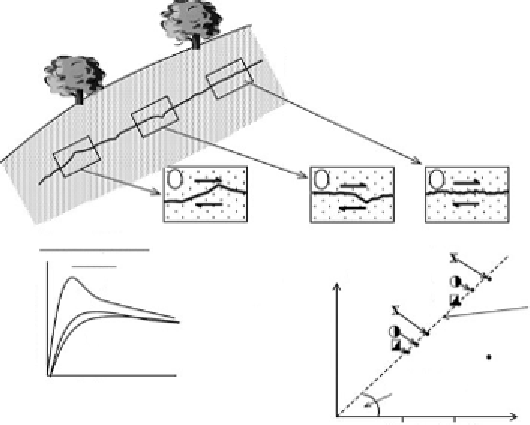Geology Reference
In-Depth Information
Figure 5.22
Methodology for
selecting a series of
samples of rock
joint, testing and
basic friction angle
for the naturally
textured rock joint
(after Hencher
et al., 2011).
natural joint with three
sampling points
A
B
C
direct shear
samples
Tests on 3 different
samples
A
2
peak strengths
Graphs for same normal
stress, σ in each test)
B
2
C
2
A
strength envelope for
non-dilating joint
B
A
1
B
1
C
1
C
= strength corrected
for dilation
basic friction
angle,φ
b
disiplacement
SampleA is roughest and therefore
dilates the most and has the highest
measured strength
Stage 1
Stage 2
normal stress, σ
tests on a series of samples from the same joint set (with similar surface
mineralogy and textures) provide a reasonably well-de
ned dilation-
corrected strength envelope, as illustrated in
Figure 5.22.
That strength
is frictional (obeys Amonton
is laws) and comprises an adhesional
component plus a non-dilational damage component that varies with
texture and roughness.
Barton (1990) suggested that the dilation-corrected basic friction
angle might be partly scale-dependent, as assumed for the asperity
damage component in the Barton-Bandis model (Bandis et al.,
1981), but further research using the same testing equipment as
Bandis but with better instrumentation, indicates that this is unli-
kely (Hencher et al., 1993; Papaliangas et al., 1994). Dilation-
corrected basic friction is independent of the length of the sample.
Scale effects do need to be taken into account in design but as a
geometrical consideration when deciding on an appropriate
'
eld
scale i° value.
Many silicate rocks are found to have a basic friction
40 degrees
(Papaliangas et al., 1995), and Byerlee (1978) found the same strength
envelope (
ϕ
≈
b
τ
σ
) for a large number of direct shear tests on various
rock types where dilation was constrained by using high con
= 0.85
ning
stresses. Empirically, it seems to be about the highest value for basic
friction achievable for natural joints in many silicate rocks and applic-
able speci
cally to joints that are forced to dilate during shear or where
dilation is suppressed because of the high normal load. Conversely,
much lower friction angles can be measured for natural
joints

